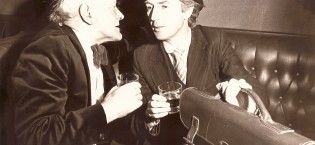Impressions of a Students At Yeats Summer School
I looked forward very much to seeing the two Yeats plays as they are an important feature of the Summer School. “Deirdre” and “The Cat and the Moon” were two contrasting plays in a double bill. “Deirdre” is an immensely difficult play to stage and to act. Part stylised, part realistic, part ritual and part drama. It contains elements of classical Greek drama in its chorus, and elements of Shakespeare in its noble verse. The theme has much in common with the fate of the other great lovers of legend and literature and Yeats used it to create a play where his search for perfection in his art is clearly visible. The part of Deirdre is a great challenge. One of the heroines of world history and legend she is as powerful in our imaginations as Helen of Troy or Cleopatra. Yeats compressed the story into one act telling of the trickery practised by Conchubar which led Naoise and Deirdre to their deaths.
The diction of the players was exemplary. The musicians as the chorus coped with the mixture of incantatory and colloquial styles, established the note of Yeats’ “terrible mysterious things”. Led by the fine speaking and singing of Joan Fitzpatrick with Ann Mc Dermott and Fiona Maguire, the chorus was quite impressive. The young Deirdre of Jane Fitzpatrick was no ‘wild eagle’, but a serious and beautiful queen, speaking her lines with true conviction and rhythmical expression. John Mullaney, relaxed and assured both in move and speech, gave Conchubar an authority and something of the stylised panache of the Player King in Hamlet. Walter Mc Donagh’s direction opened a door to Yeats’ world of myth and mystery.
“The Cat and the Moon” was I thought the most successful of the three plays I saw. Yeats, by using the poem as a framework for the legend of the blind beggar and the lame man visiting a well hoping to be cured, stressed the importance of the occult combined with myth and legend, to feed man’s inner life. The play, part dance, part song, part speech, demand the use of masks. The giant grotesque faces designed by Catherine Mc Donagh were quite remarkable. Martin Mc Dermottroe and Brian Bohan as the blind man and the lame man gave a performance of delightful gusto. Again the chorus of musicians were exceptionally good, the costumes by Caroline Pilkington inspired, while the choreography by Mary Mc Donagh added much to the two Yeats productions. Walter Mc Donagh’s production of “The Cat and the Moon” wove the two strands of the play into a moment of comical magic. The programme notes by Eileen Lambert added to our knowledge of Yeatsian drama. It is not surprising that Sligo Drama Circle has won awards in All-Ireland competitions. They are an outstandingly good company, one of which Sligo may justly be proud.
“The Black Stranger” by Gerard Healy – this production performed by the Sligo Drama Circle produces an effect of culture-shock on an overseas visitor. The Great Famine we know as an historical fact. I was first made aware of the appalling extent of the catastrophe by reading “The Great Hunger” by Cecil Woodham-Smith. Eileen Lambert’s valuable and carefully researched programme notes related the tragedy to Sligo. This prepared us for the play and brought it into sharp focus. The strength of the play lies, in my view, in the strong emotional pull of history brought near to home. The strength of the performance lay in it being given by Sligo people re-enacting their own history. The actors gave the drama true feeling. The older members of the cast set a good dramatic pace, while the younger people put real vitality into their roles. I was particularly struck by the eergy of Tony Mc Niffe as Danny and the really moving performance of Brenda Barrett as Bridie. Ann Mc Dermott looked and acted well as the mother. The producer was Joe Meehan and I have been assured the Irish cottage of the period was authentic.
from The Sligo Champion, August 26th, 1977, by Angela Wyndham-Lewis
Tags: Gerard Healy, History, Press Reports, Reviews, W.B. Yeats







